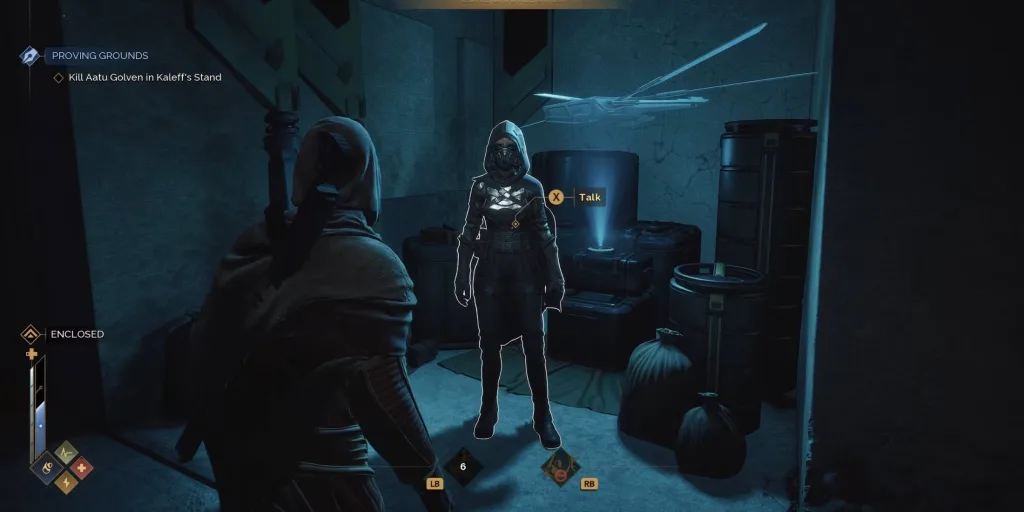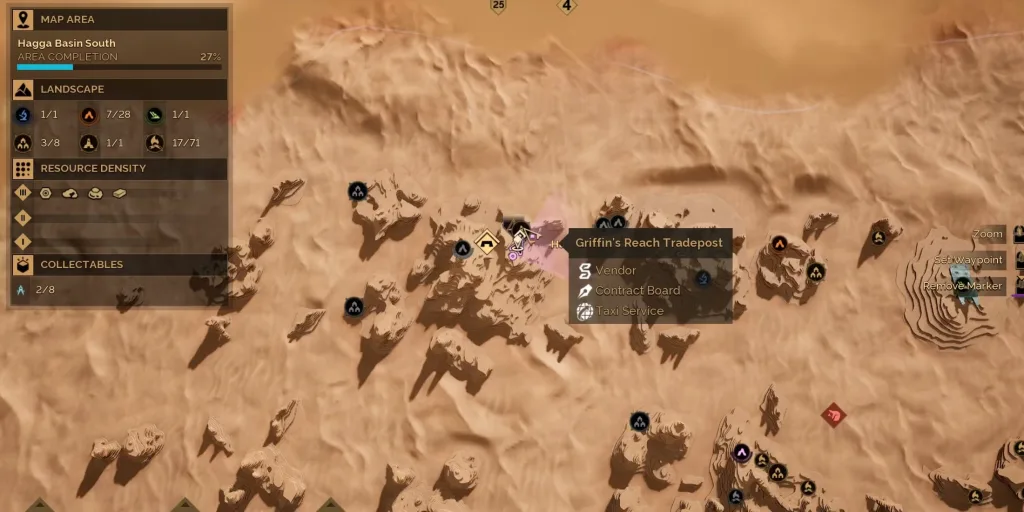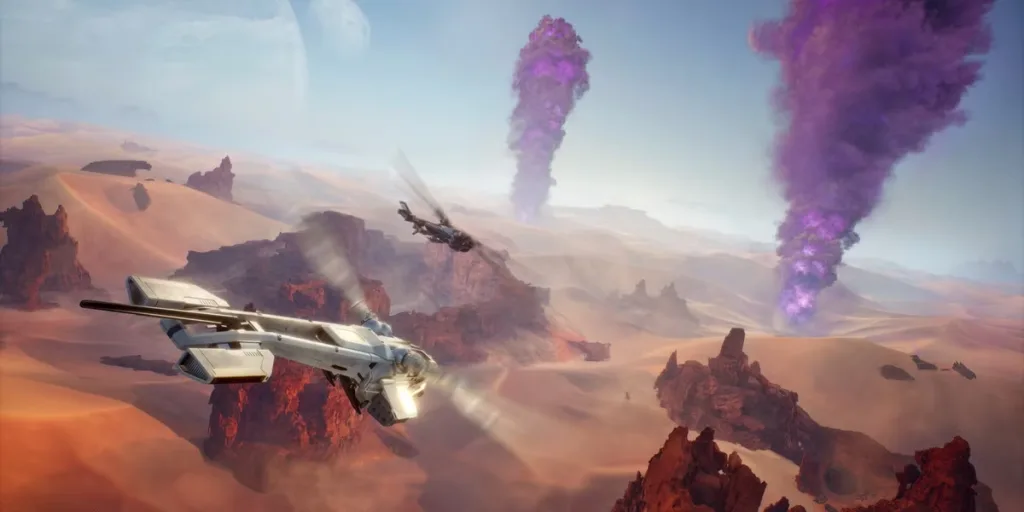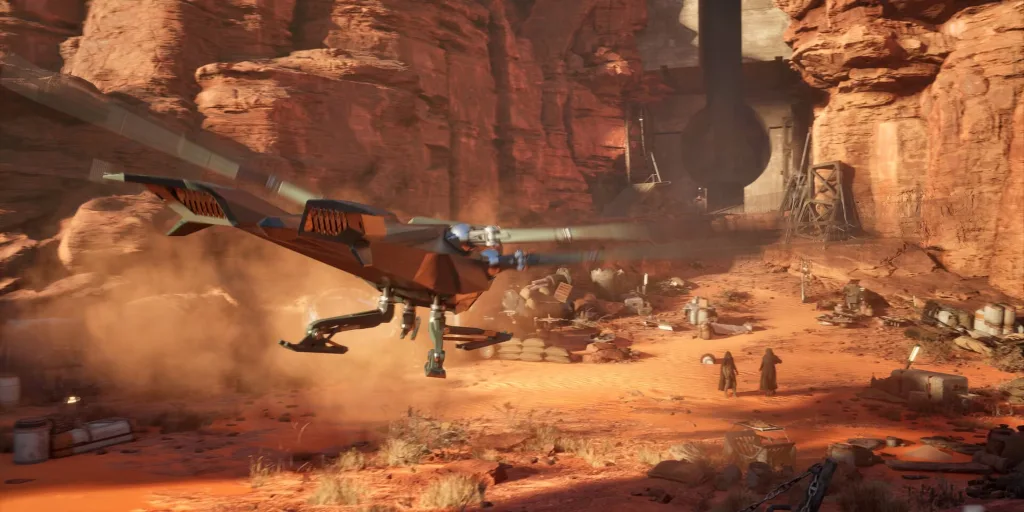The harsh desert planet of Arrakis stretches endlessly before you in Dune Awakening, its shifting sands concealing both incredible treasures and deadly perils that await those brave enough to venture beyond the safety of established settlements.
As you emerge from your initial shelter and begin to comprehend the sheer magnitude of this survival MMO’s world, the reality of traversing such vast distances on foot becomes a daunting prospect that could consume countless hours of precious gameplay time. The planet’s unforgiving landscape, punctuated by towering rock formations, sprawling trade posts, and the ever-present threat of sandworm encounters, demands a more efficient approach to exploration and resource gathering.

Fortunately, Funcom has woven an elegant solution into the fabric of Dune Awakening’s world that perfectly captures the essence of Frank Herbert’s universe while addressing the practical needs of modern gaming. The Ornithopter fast travel system represents more than just a convenient gameplay mechanic; it embodies the technological marvels that enable civilization to thrive on humanity’s most challenging frontier world.
These graceful flying machines, piloted by skilled operators stationed throughout Arrakis’s major settlements, offer weary travelers the opportunity to soar above the dangerous desert floor and reach distant destinations in mere moments rather than potentially perilous hours of ground-based travel. Understanding and mastering this transportation network becomes essential for any player serious about maximizing their efficiency and survival prospects in the unforgiving world of Dune Awakening.
Table of Contents
Understanding the Dune Awakening Fast Travel System
The Ornithopter fast travel system in Dune Awakening operates as a sophisticated transportation network that mirrors the logistical challenges of maintaining civilization on a hostile desert planet. Unlike traditional fast travel mechanics found in many survival games, this system requires both strategic planning and economic consideration, as each journey demands payment in Solari coins, the precious currency that drives commerce throughout the known universe. This economic component adds a layer of meaningful decision-making to every travel choice, forcing players to weigh the value of time saved against the financial cost of convenience.

The system’s integration into the game’s narrative structure demonstrates Funcom’s commitment to authentic world-building that respects the source material while serving gameplay needs. Rather than simply providing instant teleportation between arbitrary waypoints, the Ornithopter network functions as a believable infrastructure element that great houses and trading organizations would naturally establish to facilitate commerce and communication across Arrakis’s vast territories. Each pilot represents a crucial link in this chain of connectivity, stationed at strategic locations where travelers naturally congregate and conduct business.
What makes this system particularly compelling is its gradual expansion mechanism, which encourages exploration and progression while maintaining the sense of discovery that drives survival gameplay. Initially, players gain access to only a handful of destinations, but as they venture into new territories and establish relationships with various factions, additional flight routes become available. This organic growth of transportation options creates a satisfying progression curve that rewards adventurous players with increased mobility while ensuring that the early game maintains its sense of challenge and discovery.

Unlocking Your First Ornithopter Flight: The Wider World Quest
The journey toward unlocking Dune Awakening’s fast travel system begins with completing the foundational “A Wider World” quest, a carefully designed introduction that naturally guides players toward their first encounter with an Ornithopter pilot while establishing the narrative context for this transportation network. This quest emerges organically during the “A Touch of Civilisation” questline, appearing when players reach Griffin’s Reach Tradepost, a bustling commercial hub that serves as many players’ first glimpse of Arrakis’s complex economic ecosystem.
Griffin’s Reach Tradepost represents more than just another destination on the map; it embodies the intersection of commerce, survival, and technological advancement that defines civilization on Arrakis. As players approach this settlement during their quest progression, they witness firsthand how established communities leverage advanced technology and strategic positioning to thrive in an environment that destroys the unprepared. The automatic triggering of “A Wider World” upon reaching this location demonstrates the quest designers’ understanding that players naturally arrive at this point ready to expand their operational scope beyond immediate survival concerns.
The quest’s structure serves multiple purposes simultaneously, introducing players to the economic realities of Ornithopter travel while providing narrative context that explains why such services exist and how they function within the broader world. By requiring players to speak directly with an Ornithopter pilot as part of their quest objectives, the game ensures that every player discovers this crucial system through natural progression rather than accidental encounter. This approach creates a memorable introduction that players are likely to remember and utilize throughout their continued adventures on Arrakis.

Locating Ornithopter Pilots Across Arrakis
Ornithopter pilots maintain strategic positions throughout Arrakis’s major settlements and trading posts, their locations carefully chosen to maximize accessibility while maintaining the security necessary for operating expensive and sophisticated flying machines in a dangerous environment. These skilled aviators typically establish their operations within substantial buildings that offer protection from the desert’s harsh elements and potential threats, creating easily recognizable hubs that players can identify and remember across multiple visits.
In Hagga Basin, one of the most accessible regions for new players, pilots operate from within large, well-constructed buildings that stand out against the surrounding landscape through their size and architectural sophistication. These structures serve dual purposes, providing both operational facilities for the Ornithopters themselves and comfortable waiting areas where passengers can conduct business and prepare for their journeys. The pilots position themselves prominently within these buildings, usually in corners or designated areas where they can easily observe incoming traffic while maintaining clear sightlines to their aircraft.
The distribution of pilot locations reflects the economic and strategic realities of maintaining an air transportation network on a planet where every resource must be carefully managed and protected. Major cities and established trading posts naturally attract these services due to their concentrated populations and regular commercial activity, creating the passenger volume necessary to sustain profitable operations. As players progress through the game and unlock access to additional regions, they discover that each significant settlement maintains its own pilot services, creating an interconnected network that spans the explored portions of Arrakis.

Understanding Ornithopter Travel Costs and Economics
The economic structure of Ornithopter travel in Dune Awakening reflects the complex realities of maintaining advanced technology on a resource-scarce desert planet, where every component must be imported, maintained, and protected against the corrosive effects of sand, heat, and constant use. The pricing system operates on a distance-based model that accounts for fuel consumption, pilot compensation, aircraft maintenance, and the inherent risks associated with traversing different regions of Arrakis, creating a logical framework that players can understand and plan around.
Short-range flights within the same region, such as movement between different locations within Hagga Basin, typically cost 700 Solari coins, a price point that makes local transportation accessible for players who have established basic economic foundations but still requires meaningful consideration before each journey. This pricing structure encourages players to group their activities efficiently, planning routes that maximize the value received from each flight while discouraging frivolous or poorly planned travel that could quickly drain limited financial resources.
Long-distance inter-regional flights command significantly higher prices, with journeys to distant locations like Arrakeen or Harko Village requiring 2,500 Solari coins or more depending on the specific route and current market conditions. These premium prices reflect both the increased operational costs of extended flights and the greater risks associated with traversing multiple regions, including potential encounters with sandworms, hostile weather patterns, and territorial disputes between competing factions. Players must carefully balance the time savings offered by these expedited journeys against the substantial financial investment required, often leading to strategic decisions about when long-distance travel justifies its cost.
The system’s economic balance ensures that fast travel remains a meaningful choice rather than an automatic solution to every movement challenge. Players who invest time in building their Solari reserves through successful trading, resource gathering, or quest completion gain access to greater mobility options, while those struggling economically must rely more heavily on ground-based transportation methods that consume time but preserve precious currency for other essential purchases.
Expanding Your Travel Network Through Exploration
The gradual expansion of available Ornithopter destinations creates one of Dune Awakening’s most satisfying progression elements, rewarding players who venture into unexplored territories with increased convenience and strategic options for future expeditions. This system encourages thorough exploration by making each newly discovered settlement or trading post a potential addition to your personal transportation network, transforming what might otherwise be one-time visits into valuable long-term infrastructure investments.

As players progress through different regions and complete various faction questlines, they unlock additional flight routes that reflect their growing influence and recognition within Arrakis’s complex political landscape. This organic expansion process ensures that transportation options develop in parallel with player capabilities and storyline progression, creating a sense of earned advancement that enhances the overall feeling of character development and world mastery.
The discovery of new pilot locations often coincides with significant story developments or faction relationship milestones, reinforcing the connection between narrative progression and gameplay convenience. Players who invest time in building relationships with different houses and trading organizations frequently discover that their diplomatic efforts unlock exclusive flight routes or discounted travel rates, creating additional incentives for engaging with the game’s complex political systems.
Strategic Tips for Maximizing Fast Travel Efficiency
Successful utilization of Dune Awakening’s Ornithopter network requires strategic thinking that extends beyond simple point-to-point transportation, encompassing resource management, route planning, and timing considerations that can significantly impact overall gameplay efficiency. Players who master these strategic elements often find themselves able to accomplish far more within limited play sessions while maintaining healthy Solari reserves for other essential expenditures.
Batching activities by region presents one of the most effective strategies for minimizing transportation costs while maximizing productivity. Rather than making multiple individual trips to complete scattered objectives, experienced players plan comprehensive regional expeditions that address multiple goals simultaneously, from resource gathering and quest completion to trading and social interactions. This approach requires advance planning and organization but delivers substantial savings in both time and currency while ensuring that each expensive flight provides maximum value.
Timing considerations also play a crucial role in efficient fast travel utilization, particularly regarding the game’s dynamic events and seasonal changes that can affect both resource availability and travel costs. Players who monitor these patterns often discover optimal windows for certain types of expeditions, such as major trading runs or resource gathering missions that benefit from specific environmental conditions or market fluctuations.
Frequently Asked Questions
Q: Can I use Ornithopter fast travel immediately after starting Dune Awakening, or do I need to progress through specific quests first?
A: You cannot access Ornithopter fast travel immediately upon starting the game. The system becomes available only after completing the “A Wider World” quest, which automatically triggers when you reach Griffin’s Reach Tradepost during the “A Touch of Civilisation” questline. This ensures that players have sufficient game knowledge and Solari coins to use the system effectively before gaining access to it.
Q: Are there any ways to reduce the Solari coin costs for Ornithopter travel, or do all players pay the same rates regardless of their progress or faction relationships?
A: While the base rates remain consistent across all players, there are indirect ways to make fast travel more economical. Some faction relationships may provide access to exclusive routes or occasional discounted rates, and efficient Solari farming through trading, resource gathering, and quest completion can make the costs more manageable. However, the primary strategy for cost management involves batching activities by region to maximize the value received from each flight rather than seeking direct price reductions.








